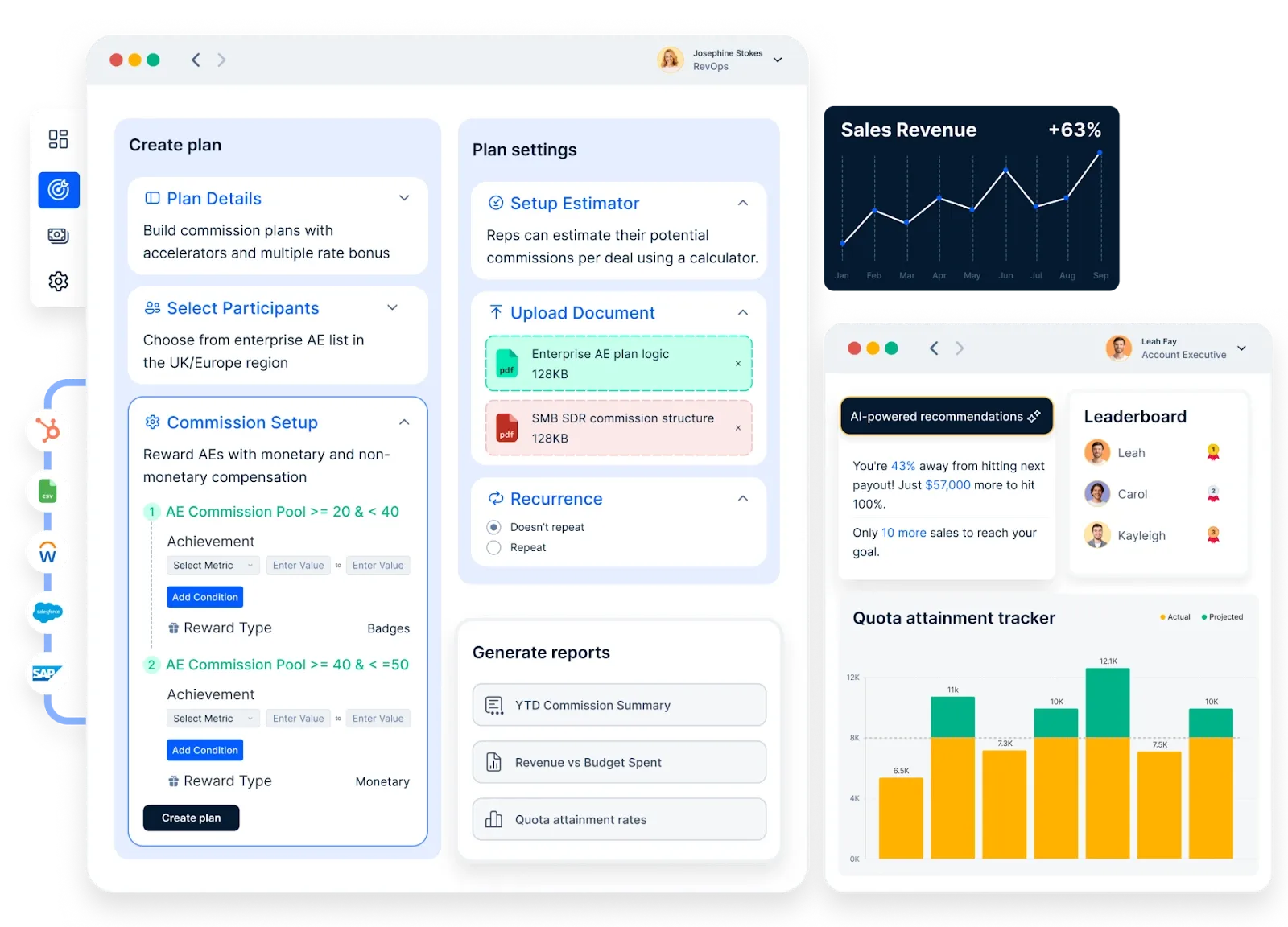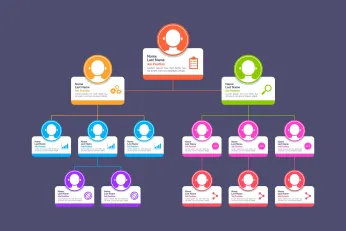Nesta página
Inside sales or outside sales? The most argued question is, which strategy is best for you? Considering today's market, both roles are merged and have become a significant part of the sales company.
So, do you find these lines blur? Can inside sales be called the usual sales? Wondering which go-to-market can be selected here?
Let's explore the relationship between inside and outside sales and study what fits best in contemporary sales teams.
What is inside sales?
Inside sales involves selling remotely through channels like phone, email, and social media. It's often called remote or virtual sales due to its digital nature. Inside sales reps use messaging apps, video conferencing, and traditional methods. It's common in tech, B2B, and SaaS industries.
Example: A software company uses webinars and email marketing to generate leads and close deals remotely.
What do inside sales reps do?
Inside sales reps work from a central location, avoiding face-to-face meetings. They focus on prospecting and engaging leads interested in the company's offerings. There are two approaches:
- Inbound sales: Addressing inquiries from prospects who contact the business.
- Outbound sales: Proactively reaching out to potential customers.
Communication occurs live via calls or chat, or asynchronously through online forms and messages.
Example: An inbound sales rep at a marketing agency promptly answers queries coming through the company's website to convert visitors into leads. An outbound sales rep makes cold calls to businesses to introduce the agency's services.
What are outside sales?
Outside sales involves representatives traveling to meet prospects in person at offices, conferences, and events.
It's the more traditional sales approach, like field sales. Reps connect with customers through various channels, using smartphones and mobile devices.
Example: Pharmaceutical sales representatives visit doctors' offices and hospitals to promote their company's medications.
What do outside sales reps do?
Outside sales representatives are primarily in the field. They meet with customers to discuss solutions, demo products, and build strong relationships.
Example: A construction equipment sales rep visits a building site to showcase the features of a new excavator model to the project manager.
As per the Xant.ai report of 2021, outside teams are doing 25% more calls and 50% higher email activities.
The tools used by inside and outside sales reps are the same, including CRM, email, and social media.
The HubSpot 2021 Sales Enablement Survey found that 68% of sales professionals chose a hybrid or a completely distant selling model in 2021.
Inside sales vs outside sales: The major differences
Parameter | Inside Sales | Outside Sales |
Custo | Relies on technology and communication tools. Inside sales reps can connect rapidly via email and phone. | Involves travel, accommodations, and face-to-face meeting expenses. |
Sales Cycle | Shorter sales cycles are typical, focusing on smaller, more transactional sales. | Sales cycles are longer, emphasizing relationship building and in-person negotiations. |
Lead Management | Prioritizes quality leads. Reps focus on email, calls, and nurturing client relationships, but with less time investment per lead. | Requires significant time spent on fostering connections and in-person meetings. |
Escalabilidade | Easier to implement standardized procedures for inside teams. Training and new techniques are simpler to roll out in a central workspace. | Training and implementation are more challenging due to reps working in various locations. Success relies heavily on individual client relationships. |
Point of Contact | Primarily uses email, calls, and messages. | Focuses on face-to-face meetings. |
Sales Tools | Relies on phones, computers, and CRM systems within the office. Cloud computing and smartphones are increasingly relevant. | Uses CRM and phones while traveling. Face-to-face interaction remains the core tool. |
Desired skill sets of outside vs. inside sales reps
Different skills are needed for success in inside versus outside sales. Inside sales reps need strong communication and tech skills, while outside sales reps need relationship-building and negotiation skills.
Inside and outside sales reps need unique abilities and behavior traits to gain success. For example, an excellent outside sales representative needs a high emotive proportion and situational experience.
They should be aware of social cues, make immediate decisions, answer queries and keep the client interested. Being on the work location offers a lot of autonomy. An efficient outside sales rep is more like a motivated person who doesn't need consistent supervision from their sales managers.
On the other hand, inside sales representative require a higher focus to gain success. They follow the instructions of their sales manager. Most companies offer inside sales reps' templates and scriptures to make the workflow effective and smooth.
Both need common skills, which include good communication abilities, perseverance, and confidence.
Skill Set | Inside Sales | Outside Sales |
Key Skills | Communication, tech proficiency, persistence | Relationship building, negotiation, presentation |
Product Knowledge | Deep, specialized knowledge | Broad, application-focused knowledge |
Personal Style | Energetic, persuasive | Confident, consultative |
Exemplo | Mastering product demos via webinar | Closing a deal over dinner with a client |
Common business impacts: Inside vs. outside sales
Inside and outside sales significantly affect a business in different ways. Inside sales often drive higher volume with lower costs, while outside sales build deeper relationships and secure larger deals.
Impact Area | Inside Sales | Outside Sales |
Focus | Volume, efficiency | Relationship, large accounts |
Custo | Lower (less travel, overhead) | Higher (travel, entertainment) |
Deal Size | Smaller, more frequent | Larger, less frequent |
Exemplo | Selling software subscriptions online | Selling heavy machinery to a factory |
Inside sales vs. outside sales team structure
The structure of inside and outside sales teams differs to optimize their respective strengths. Inside sales teams often have a hierarchical structure, while outside sales teams are more geographically distributed.
Team Structure | Inside Sales | Outside Sales |
Organization | Centralized, often hierarchical | Decentralized, geographically focused |
Communication | Primarily digital (phone, email, CRM) | In-person meetings, regional offices |
Management | Close supervision, data-driven metrics | Autonomous, results-oriented |
Exemplo | A team of reps in a call center | Regional managers covering territories |
Inside vs. outside sales models
Choosing a sales model isn't as simple as it once was. Traditionally, B2B sales teams based this decision on their offerings. Outside sales focused on selling physical products to larger companies. Inside sales handled smaller businesses and lower-cost services.
Now, technology allows innovative approaches to showcase products and finalize complex deals through different channels. Think virtual meetings, demos via Zoom, and self-service options with inside sales support via live chat.
Here's a typical structure of inside and outside sales models across a standard five-step sales process:
Aspeto | Inside Sales | Outside Sales |
Prospecting | Lead follow-up from marketing (free trials, webinars). Social selling (reaching out via social media). Cold emails and calls. | In-person cold-calling. Live events (trade shows, networking). |
Qualifying | Automated lead scoring. Questionnaires. Virtual meetings. | In-person consultative selling (discussing needs). |
Presenting | Virtual, interactive demos (slide decks, software). | In-person visual presentations (slide decks). Interactive demos. Brochures, handouts. Physical product demos. |
Closing | Electronic contract signing. | In-person meetings with decision-makers. |
Following Up | Virtual training. Referral program setup. Sending gifts/notes via mail. | On-site training. Entertaining clients (lunches, etc.). |
Inside sales vs outside sales: Finding the right fit for your business
Selecting inside vs. outside sales is a significant decision for a business. A big chunk of the salesforce includes outside sales representatives, but things are changing now. The inside sales teams are expanding 15 times quicker than outside sales teams.
Many aspects are considered before selecting a sales arrangement.
- Is the product offline or online?
- Are you catering to a global customer base?
In such situations, inside sales is a better option for you. Draft your sales team's objective on the general company goals.
To enhance the performance, ensure your sales management chooses SMART objectives- Specific, Measurable, Attainable, Relevant, and Time-specific.
If the product is challenging and needs a demonstration for the client to understand, choose the outside sales framework. To ensure the highest productivity, draft an efficient scheduling system for your sales staff. Every sales representative should have specific areas to avoid overlapping and confusion. It would help if you considered appointing local sales representatives as they know these regions better.
In today's time, a hybrid method has gained fame with companies. Usual sales-focused organizations use inside and outside sales as it shields higher ground instead of one approach. F2F sales offer a customized experience.
Most people are still hesitant to make bulk purchases online. But online purchases are highly convenient. Hence, a hybrid model helps you target customers who need customized help and those who need accessibility.
Optimize Your Sales Team’s Efficiency with Compass

With solutions like Get compass, businesses can streamline commission tracking for both inside and outside sales reps. By automating payouts and aligning incentives with performance, companies can drive higher engagement and efficiency.
Schedule a call now! https://www.getcompass.ai/book-a-demo
Conclusão
Now that you are aware of the difference between inside sales and outside sales, you can make a precise decision. If you decide between inside sales vs. outside sales, ensure to make the right balance to prepare a winning recipe. Building an inside sales team is cost-effective and highly scalable.
But, if you have a long sales cycle with organizations, then choose an outside sales team. And, wherever needed, choose a hybrid approach to bring tremendous success to your company.
FAQs
1. Is inside sales better than outside sales?
The provided text doesn't definitively say one is "better." It implies that the ideal choice depends on factors like the product/service, target customer size, and available technology. Modern businesses often use a combination of both. The text emphasizes that technology is changing how both inside and outside sales operate.
2. What is an example of inside sales?
Based on the text, examples of inside sales activities include:
- Lead follow-up from marketing efforts (free trials, webinars)
- Social selling via social media outreach
- Cold emails and cold calling via phone
- Automated lead scoring and questionnaires
- Virtual meetings and interactive demos
- Electronic contract signing
- Virtual training and setting up referral programs
3. Is inside sales cold calling?
Yes, the provided text includes "cold emails and cold calling via phone" as a prospecting activity used in inside sales.
4. What are the disadvantages of inside sales?
The document does not specify the disadvantages of inside sales. Here are some common disadvantages of inside sales:
- Building relationships: Difficulties in building strong relationships due to a lack of face-to-face interaction.
- Communication challenges: Potential for miscommunication or lack of nuanced understanding compared to in-person meetings.
- Competition for attention: Overcoming distractions and holding attention in a virtual environment can be challenging.
- Limited physical presence: Inability to physically demonstrate products or assess the customer's environment firsthand.
- Dependence on technology: Reliant on technology, which can be problematic if systems fail or there are connectivity issues.














